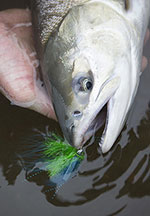Alaska Fish & Wildlife News
September 2016
Turning a Moose Hide Into Buckskin
Brain-Tanning Alaska Big-Game Animal Skins at Home

For most of human history, the skins of harvested big-game animals were not discarded by hunters. As a product of the hunt, skins were just as essential to the survival of northern hunting cultures as were an animal’s meat, fat, and organs. The hide was saved and processed into indispensable items: rawhide rope and cord, tanned skin for clothing, gloves, footwear, bags, pouches, quivers, blankets, shelter covers and much more. While it is safe to say that most bear skins are retained by ... Tanning a Hide Article Continued
Chums on the Fly

The brawny fish turned slightly against my grip, laying itself side up on the surface of the water as a faint beam of light struck the subtle figures of color running vertical across the plane of scale and fin. She didn’t come easy. These beautiful fish seldom do. I had to fight for her. Tighten the drag on my fly reel down as she bulleted through the force of a descending current.
I watched her strike. Bolt from the shadow of a mid-stream riffle, following the gaudy path of the fly ... Chums on the Fly Article Continued
Alexander Creek and the Impacts
of Illegal Introductions of Northern Pike

Northern pike are native to Alaska, both north and west of the Alaska Range. Where they are native, they are considered a prized, sought after fish - both because of their size and voracity, and also because their flaky white flesh makes for excellent table fare. However, in areas where they are not native and have been illegally introduced they are capable of creating catastrophic impacts to native fish and animal communities.
Northern pike were illegally introduced to the Susitna drainage ... Illegal Pike Article Continued
Western Arctic Caribou Herd Update

A population survey conducted earlier this summer places the Western Arctic caribou herd at 201,000 animals, indicating the herd’s recent rate of decline has eased greatly.
“The results of this photocensus imply that the population has continued to decline since 2013, albeit at a much reduced rate, which seems to be improving each year” said Caribou Biologist Lincoln Parrett.
The summer survey supports information gathered earlier by state biologists indicating ... Caribou Update Article Continued
